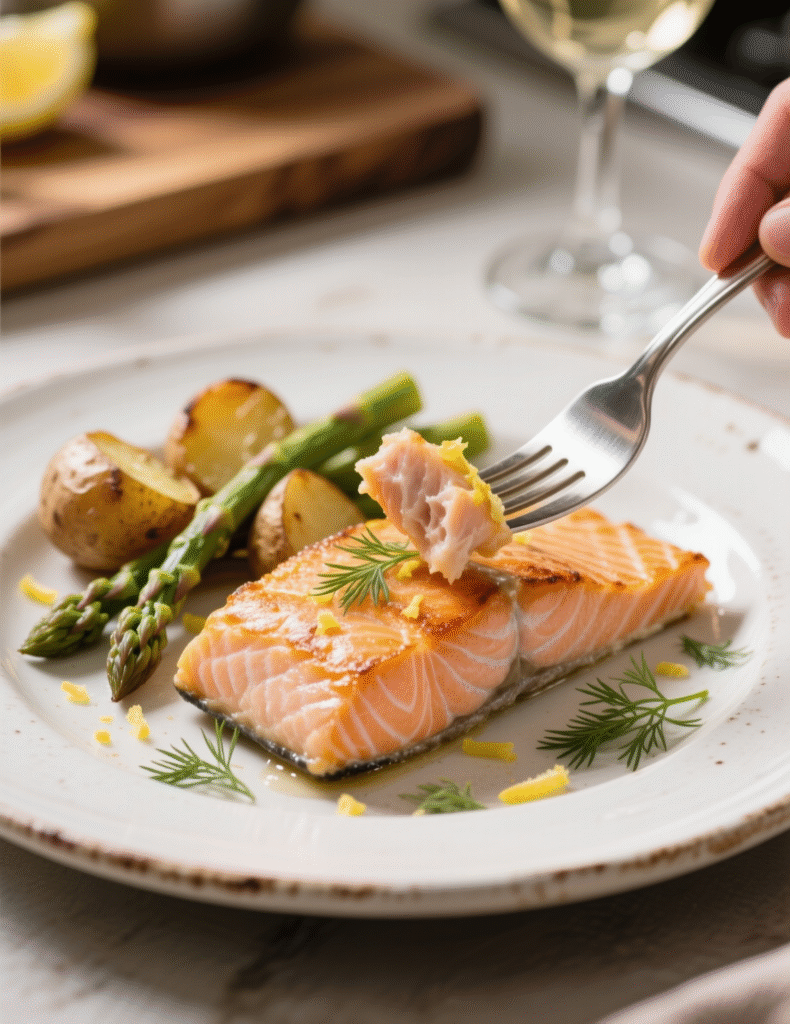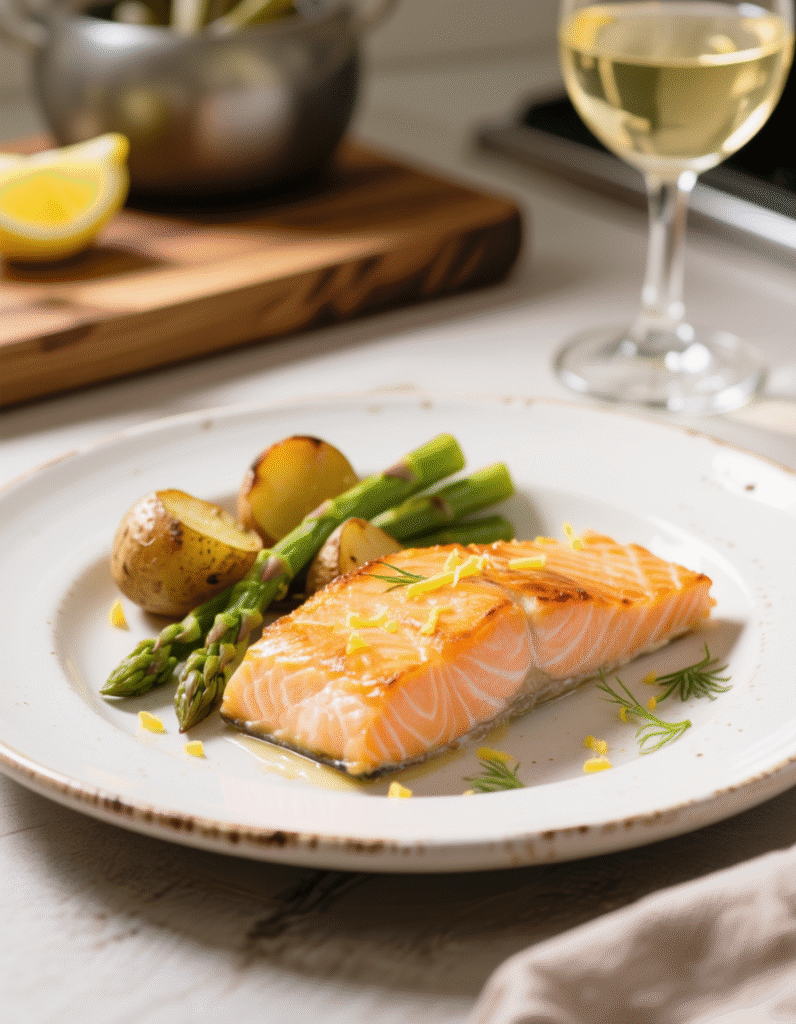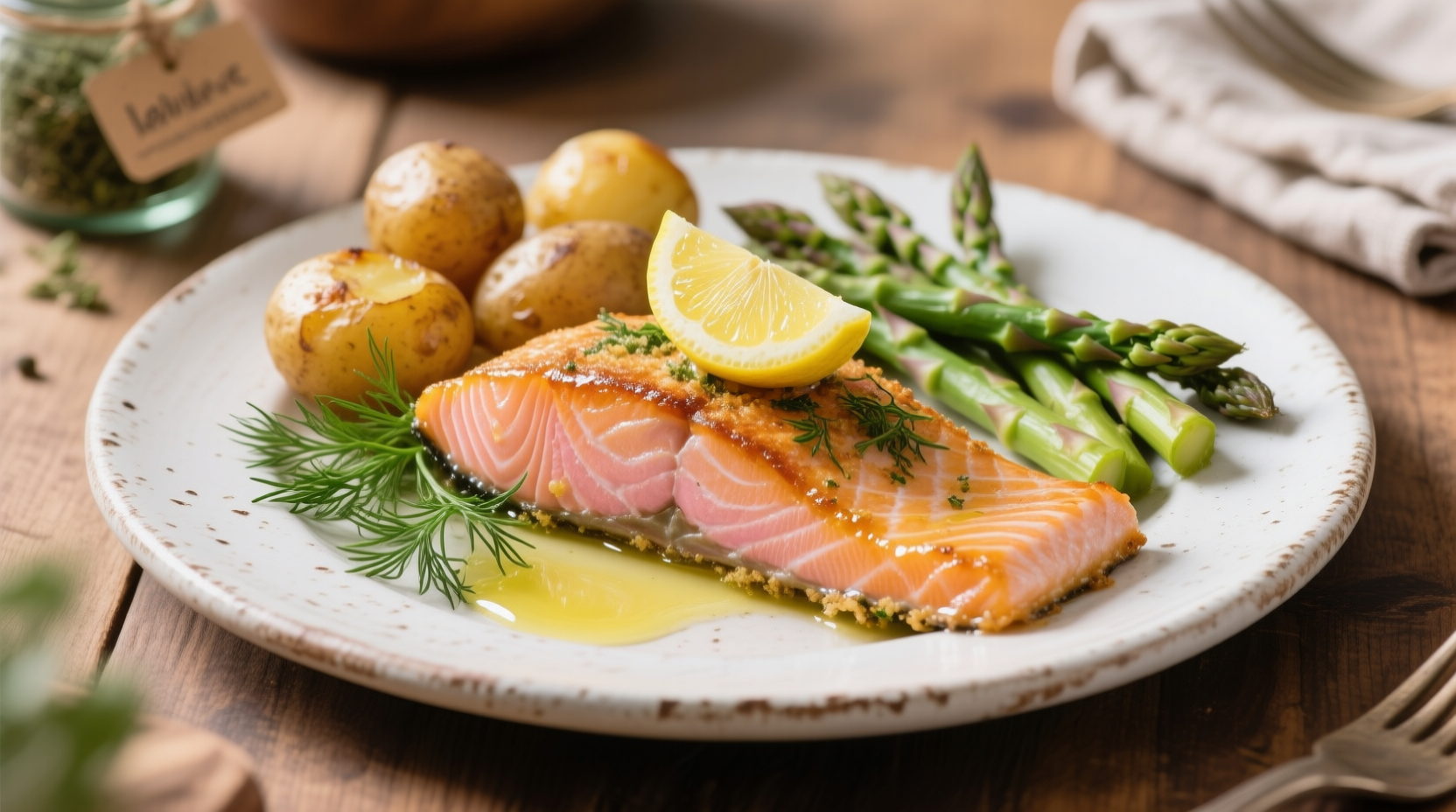There are recipes that stay in your head after one single bite. Lemon dill salmon is one of them. It has this crisp clarity, like a sentence without wasted words, and yet it’s layered, complex, almost sneaky in how much depth hides behind such simplicity. In this piece, we’ll dive deep—not just into how to make it—but why it works, why professionals love it, and why it always seems to taste like more effort than it actually takes.
Why Lemon and Dill Make Such a Powerful Pair
Lemon and dill aren’t just thrown together by accident. Culinary science shows us why this pairing works so well. Lemon provides high acidity, cutting through the natural fattiness of salmon. Dill, with its subtle grassy-anise aroma, tempers sharpness and lifts the fish without dominating.
Salmon contains around 13 grams of fat per 100 grams, most of it omega-3 fatty acids. These fats love acidity. They cling to lemon juice like a magnet, balancing richness with brightness. Dill is lighter but aromatic; it prevents the dish from being one-note. Together, they create what chefs call flavor layering. One element hits sharp, another rounds it off, leaving the palate refreshed.
Choosing the Right Salmon
Not all salmon are equal, and chefs know the source makes or breaks the dish. Wild-caught sockeye has a leaner, firmer texture and bolder flavor. Atlantic salmon, farmed more often, is fattier, with a milder taste, which actually suits lemon-dill profiles beautifully.
Freshness is everything. Look for flesh that’s moist but not slimy, firm to touch, and with no fishy odor—just a faint briny smell, like the ocean at low tide. A 2021 NOAA report showed that nearly 70% of American salmon consumption is farmed Atlantic, so many home cooks are unknowingly adapting to that profile already. Professionals adjust their seasoning slightly depending on fat levels: more lemon zest and lighter oil for fattier fillets, a touch of butter for leaner ones.
The Technique Behind the Simplicity
A mistake I see home cooks make often: overcomplicating salmon. Garlic, capers, wine, cream—sometimes it all just bulldozes the delicate flesh. The truth? Salmon doesn’t need much babysitting. The perfect lemon dill salmon is about restraint.
Cooking method matters. Pan-searing gives crisp edges but risks overcooking the center if timing is off. Baking at moderate heat (375–400°F) provides control and even cooking. Poaching in a lemon-dill broth is classical French, producing silky texture, though less dramatic presentation. Grilling? Gorgeous smoky notes, but you need skin-on fillets and a confident hand.
What’s common across methods: don’t cook salmon beyond 135°F internal temperature. USDA says 145°F, but professionals know carryover heat handles the last few degrees. Pull it earlier and you’ll get moist flakes instead of chalky dryness.

Building Flavor in Layers
The real trick isn’t just throwing lemon juice on top. It’s staging. Zest goes into the marinade or rub—it carries essential oils, volatile and potent. Juice comes later, brushed just before serving, so it tastes alive instead of baked flat. Dill, too, has timing rules: chopped stems can handle a bit of cooking, but feathery fronds should finish the dish raw, otherwise they collapse into nothingness.
Think of it like music. You don’t start with the chorus. You build. Oil or butter lays the baseline, lemon zest adds treble, dill stems bring harmony, and the final fresh sprigs are the encore.
An Expert Recipe: Lemon Dill Salmon
Ingredients (serves 4):
- 4 salmon fillets, 6 oz each, skin on
- 2 tbsp olive oil (or melted butter, if using leaner fish)
- Zest of 1 lemon
- 2 tbsp fresh lemon juice
- 3 tbsp fresh dill, divided (1 tbsp stems, 2 tbsp fronds)
- 1 tsp sea salt
- ½ tsp freshly cracked black pepper
Method:
- Preheat oven to 400°F. Line a baking sheet with parchment.
- Pat salmon dry. Brush lightly with oil. Season with salt, pepper, and lemon zest. Scatter chopped dill stems over fillets.
- Bake 12–14 minutes, depending on thickness. Pull when internal temperature reads 130–135°F.
- Rest 2 minutes. Finish with lemon juice and sprinkle with dill fronds. Serve immediately.
Notice how lean the ingredient list looks. That’s deliberate. You’re not hiding salmon. You’re letting it talk.
Professional Tweaks and Variations
Chefs often adapt this base recipe depending on context. In high-end restaurants, you might see sous-vide salmon cooked at 122°F for melt-in-your-mouth texture, finished with a lemon-dill beurre blanc. In Scandinavia, the dish may lean toward gravlax-inspired profiles, using lemon-dill cure before a gentle roast.
Even smokehouses are borrowing the flavor combo, using cold-smoked salmon cured with lemon zest and dill. That’s how timeless this pairing has become—it survives across cooking cultures without losing identity.
Nutrition and Health Insights
Let’s be clear: this dish isn’t just tasty, it’s nutritionally potent. A 6 oz salmon fillet provides roughly 34 grams of protein and 2.3 grams of omega-3s, according to USDA data. These fatty acids lower inflammation markers and support cardiovascular health. Lemon adds vitamin C, which, although not abundant here, enhances iron absorption from side vegetables. Dill carries antioxidants like kaempferol, though in trace amounts—it’s more about aroma than nutrition.
The combination makes a light, heart-healthy dinner, fitting easily within Mediterranean diet frameworks. Dietitians often recommend oily fish twice a week, and lemon dill salmon fits neatly into that rhythm without dietary boredom.

Pairing Salmon with Sides and Wine
Here’s where many diners go wrong: pairing too heavy. Cream sauces, mashed potatoes, big reds—they smother the dish. You want brightness to match brightness.
Sides: Think roasted asparagus, quinoa with parsley, or baby potatoes tossed with olive oil and sea salt. A cucumber-dill salad echoes the herb without redundancy.
Wine: Sauvignon Blanc is an obvious pick, its citrus edge aligning with lemon. Pinot Grigio works too. For red lovers, a light Pinot Noir won’t overwhelm. Professionals in wine service often talk about “mirror and contrast”—here you mirror the lemon with acidity and contrast the fat with crispness.
Common Mistakes and How to Avoid Them
- Overcooking: the single biggest error. Use a thermometer, always.
- Old dill: wilted, yellowish dill tastes grassy in the wrong way. Always fresh.
- Too much lemon juice: it can “cook” the salmon prematurely, like ceviche, if added too early.
- Skipping the rest period: even 2 minutes off heat allows juices to redistribute.
Every misstep comes from rushing. Salmon rewards patience.
The Global Rise of Salmon-Lemon-Dill
It’s fascinating how this dish is no longer “European.” In Tokyo, chefs pair dill salmon with yuzu instead of lemon, adding a Japanese citrus edge. In the Middle East, you’ll find lemon dill salmon with a tahini drizzle, layering nutty depth. In North America, it’s the weeknight dinner hero—simple, healthy, and still restaurant-worthy.
Market research by Datassential in 2023 noted that salmon dishes with dill are on 27% more menus than ten years ago, especially in wellness-driven dining spots. That statistic shows how the profile went from niche to mainstream, without losing chef credibility.
Answering Common Questions
Can you use dried dill? Only if desperate. Fresh dill has volatile oils that vanish in drying. Dried works in a marinade but won’t sing at the finish.
Skin on or off? Always skin on for cooking. It acts as a shield from direct heat. You can peel it off later if desired.
Can you meal-prep it? Yes, but don’t overcook initially. Slightly underbake, then reheat gently to preserve texture.
Butter or olive oil? Depends on salmon type. Fatty Atlantic loves olive oil. Lean sockeye shines with butter.
Conclusion: The Beauty of Restraint
Lemon dill salmon proves something important in cooking. You don’t need twenty ingredients to make food memorable. You need the right few, handled with timing and respect.
For chefs, it’s a reminder: simplicity isn’t laziness, it’s discipline. For home cooks, it’s an invitation: dinner can be both easy and spectacular without culinary acrobatics.
At its heart, lemon dill salmon is more than a recipe. It’s a conversation between acid and fat, herb and sea. A quiet masterpiece on a plate.
FAQs
Can I use frozen salmon for lemon dill salmon?
Yes, just thaw it fully in the fridge and pat dry before cooking.
What temperature should salmon be cooked to?
Pull at 130–135°F for moist salmon; USDA suggests 145°F but that’s usually too dry.
Can dried dill replace fresh dill?
Not ideally—fresh dill has brighter oils, but dried can work in a pinch for marinades.
Should I cook salmon with the skin on?
Yes, the skin protects the flesh during cooking and can be removed after if desired.
What’s the best cooking method for lemon dill salmon?
Baking at 400°F gives the most consistent, even results with minimal fuss.
When should I add lemon juice to salmon?
At the end, right after cooking, so it tastes bright and doesn’t “cook” the fish early.
How do I prevent salmon from overcooking?
Use a thermometer and rest it briefly after removing from heat.
What sides pair best with lemon dill salmon?
Light, fresh ones like asparagus, roasted potatoes, or cucumber-dill salad.
Which wine pairs well with lemon dill salmon?
Crisp whites like Sauvignon Blanc or light reds like Pinot Noir work beautifully.
Can I meal-prep lemon dill salmon?
Yes, but slightly undercook so it reheats without drying out.

Mariana is a passionate home cook who creates delicious, easy-to-follow recipes for busy people. From energizing breakfasts to satisfying dinners and indulgent desserts, her dishes are designed to fuel both your body and hustle.
When she’s not in the kitchen, she’s exploring new flavors and dreaming up her next recipe to share with the Foodie Hustle community.

